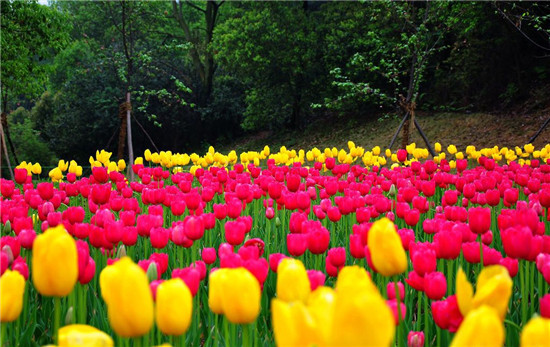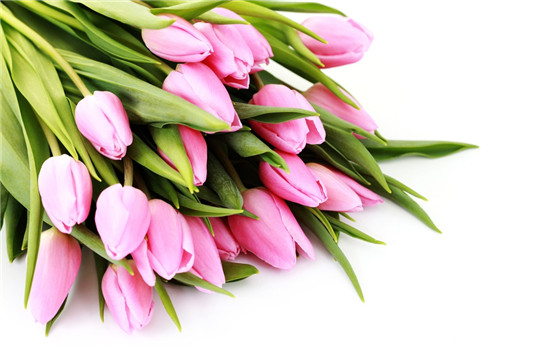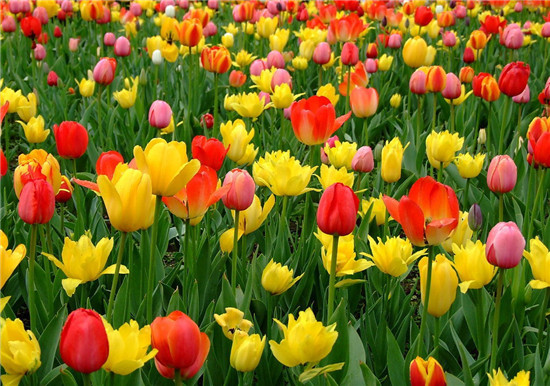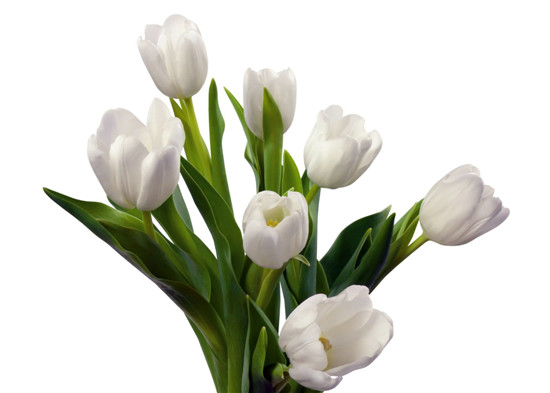An introduction to Dutch tulips the characteristics of Dutch tulips
Tulips are the most widely grown flowers in the Netherlands and are also the national flower of the Netherlands. Next let's take a look at the characteristics of Dutch tulips.

Tulips symbolize beauty, dignity, splendor and success. In the Netherlands, tulips also have a beautiful legend: there lived a beautiful princess in a castle. Three warriors fell in love with him at the same time and gave the princess a gift, a crown, a sword and a piece of gold. But the princess doesn't love anyone. So the princess prayed to the flower god, who turned the crown into flowers, the sword into green leaves, gold into stems and roots, and tulips were born.
Tulips originated in the Middle East and were introduced into Europe in the 16th century. Because tulips are similar to Muslim headscarves, they are called dulband in Farsi. The history of Dutch tulips began as a horticulturist. Clouseus, a horticulturist, is a famous botanist who got the seeds of tulips by chance. After his careful cultivation, tulips finally germinated, grew and blossomed in Europe.

The common cultivation method of Dutch tulips is bulblet reproduction, which is mainly based on the separation of bulbs. The ball is distributed from September to October in autumn, and its mother ball is annual. A new ball and several daughter balls will be born in the scale leaves of the mother ball, and the number of seed balls varies with different varieties, and the cultivation conditions will also affect it. In early June, the dormant bulbs can be dug up to remove mud. Storing it in a dry and ventilated environment is beneficial to the differentiation of bulb flower buds. Bulbs need to be stored in a well-ventilated place between 5 and 10 degrees Celsius and planted in September-October in the autumn.
At present, about 9 billion flowers are cultivated in the Netherlands every year, and if they are divided equally, everyone in the world can get two. Among them, there are 3 billion tulips. Some people infer that if these tulips are all lined up, they can circle around the equator seven times. Just imagine: is it particularly enchanting for the blue earth to wear a string of colorful tulip wreaths?

During the tulip blooming season, tourists from all over the world come to visit Kirkenhoff Park in the Netherlands. Kirkenhoff Park, located in the central city of Liess in the Netherlands, is the world's largest bulb garden and a must for the annual flower parade. The park is surrounded by flower fields, which are made up of tulips, daffodils, hyacinths, and all kinds of bulbs. There are more than 6 million flowers of all kinds in the garden, and there are many rare and rare varieties. Every spring, a flower show will be held here for about 8 weeks. at the same time, many gardening, flower arrangement and other related activities and various theme exhibitions will be arranged.
Varieties of Dutch tulips
After long-term hybrid cultivation by horticulturists, there are more than 8000 varieties in the world. It is colorful and changeable, with red, yellow and purple being the most popular. But tulips with black flowers are regarded as rare. In the 19th century, the legendary novel Black Tulip, written by French writer Dumas, praised the flower as "too gorgeous to open your eyes and too perfect to breathe". In fact, there are no pure black flowers. The black flower of the black tulip is not really black, it is like a black rose, it is red to purple. Most of these black flowers are hybrids bred by artificial hybridization. The flowers of Dutch varieties such as Widow Diane, Beauty and Queen are not pure black.

Classified by color:
1. Tulip [red] Tulip of Liliaceae
Tulip is the national flower of the Netherlands. From 1634 to 1637, it was called the period of "tulip mania" in Dutch history. New varieties and rare varieties of tulips are sold at high prices and become the object of investment pursued by people.
Flower etiquette: put a few red tulips on square hard-lined paper, fix the position with tape paper, carefully wrap transparent plastic paper, and decorate the corners with gold ribbons to add beauty.
2. Tulip [yellow] Tulip of Liliaceae
In Europe and the United States, yellow flowers are usually not very popular, and the related flower words are more negative. In fact, the clear yellow contains the joy of spring, how can people not like the eye-catching bright flowers?
Flower etiquette: because the flower stem of tulip is quite curved, it is appropriate to use a slightly larger white pattern wrapping paper, 4-5 long plants tied into a bunch, the ribbon must be yellow.
3. Tulip [white] Tulip of Liliaceae
The Australian ambassador who came to Turkey in the 16th century saw the flower for the first time. He asked the Turks around him its name and the answer was: tulip. In fact, the pronunciation refers to the Turkish headscarf, and the Turk misunderstood the meaning of the ambassador, but the flower name came into being and remained in use.
Flower etiquette: just use a few white tulips to make bouquets without adding other embellishments. The outside is white with pink tulle, and then tied gently with a few red ribbons.
The above is my summary of the introduction of Dutch tulips and the characteristics of Dutch tulips. I hope this article can help you. Please continue to follow us.
The relevant flower words also have a more negative meaning. In fact, the clear yellow contains the joy of spring, how can people not like the eye-catching bright flowers?
Flower etiquette: because the flower stem of tulip is quite curved, it is appropriate to use a slightly larger white pattern wrapping paper, 4-5 long plants tied into a bunch, the ribbon must be yellow.
3. Tulip [white] Tulip of Liliaceae
The Australian ambassador who came to Turkey in the 16th century saw the flower for the first time. He asked the Turks around him its name and the answer was: tulip. In fact, the pronunciation refers to the Turkish headscarf, and the Turk misunderstood the meaning of the ambassador, but the flower name came into being and remained in use.
Flower etiquette: just use a few white tulips to make bouquets without adding other embellishments. The outside is white with pink tulle, and then tied gently with a few red ribbons.
The above is my summary of the introduction of Dutch tulips and the characteristics of Dutch tulips. I hope this article can help you. Please continue to follow us.
Related
- Wuhan Hospital Iron Tree Blooming Result Was Instantly Frightened by the Gardener Master
- Which variety of camellia is the most fragrant and best? Which one do you like best?
- What is the small blue coat, the breeding methods and matters needing attention of the succulent plant
- Dormancy time and maintenance management of succulent plants during dormancy
- Minas succulent how to raise, Minas succulent plant pictures
- What are the varieties of winter succulent plants
- How to raise succulent plants in twelve rolls? let's take a look at some experience of breeding twelve rolls.
- Attention should be paid to water control for succulent plants during dormant period (winter and summer)
- Watering experience of twelve rolls of succulent plants
- Techniques for fertilizing succulent plants. An article will let you know how to fertilize succulent plants.



